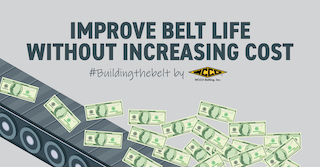"Building the Belt" - How to improve belt life without increasing cost, Blog Post

A common goal of conveyor operators is to get the longest life out of their conveyor belt. Expensive and time-consuming modifications are made to the conveyor system to prevent downtime from belt failure, but often without much effect. Repairing or replacing the belt frequently becomes the cost of doing business and turns into a standard practice for maintenance teams.
Cost is a very sensitive subject when it comes to operating and maintaining a conveyor system; the conveyor belt itself is an expensive component. But with the right belt, operators can increase belt life without increasing the cost of the conveyor system.
What drives cost?
Conveyor belts come in many sizes, styles and constructions, and can be manufactured with a variety of rubber types and fabric specifications. These features carry a physical weight in relation to cost, and ultimately, are the main drivers in the cost of a belt. Each material provides value for a specific level of performance, understanding how these features can be tailored to fit the conveyor system’s individual requirements is the first step in reducing belt cost and improving operational efficiency.
Depending on the application and industry, selecting the right belt for the job requires more than just a catalog of options. It requires a deeper look at the conveyor system, an analysis of the current belt and an investigation of current and past failure modes. Gaining perspective on what is hindering the system will shed light on the primary features required to achieve maximum performance and longevity.
Redefining belt life in the logging industry
The approach of analyzing the application and conveyor system to identify the right belt for the operation to reduce total costs was used in the logging industry. More specifically, here is an example related to infeed conveyor systems responsible for the transfer of full uncut logs to the debarker station.
Debarking is an aggressive application that demands the highest in performance and durability of both the belt and the conveyor system. The conveyor belt is under a constant barrage of falling, twisted and knotted logs, wood oils, residual moisture, ozone and UV attacks along with aggressive cover wear due to abrasion. Furthermore, there are multiple conveyor systems set-up in tandem with each one relying on the next to keep the collective system producing. A system failure during peak operation is detrimental to production, efficiencies and the bottom line.
A closer look at this conveyor system in this example revealed an inherent flaw in the design which was leading to premature belt failure from its inability to deflect impacts of incoming logs. Pan support underneath the conveyor belt prevented it from being able to flex and stretch during impact meaning the force wasn’t dissipated through the belt carcass by means of deflection. In other words, there was nowhere for the force of the log to go except into the top cover of the belt. When a cut or gouge is introduced to the top cover of the conveyor belt it can propagate to the carcass very quickly leading to expedited failure and increased service and replacement costs.
A new belting concept was designed with the needs of the application in mind. Through exploration of the deficiencies and definition of the true requirements of the conveyor system, a cost-effective solution was developed. In field testing, the conveyor operator saw a 60% increase in belt life, significantly improved performance and a 30% increase in system efficiency. Reducing down-time and repairs and maintenance combined with additional energy savings was a win for the end user.
By enlisting a belting expert like WCCO Belting to define an application’s operating requirements, conveyor operators can increase belt life without increasing the cost of the conveyor system. In fact, significant efficiencies can result and drive savings to the bottom line.
WCCO Belting's “Building the Belt” blog includes content provided by a handful of WCCO’s thought leaders on a variety of topics. The blog shares information related to behind-the-scenes value innovations incorporated into our belting products and communicate how we’re continuing to build our organization as a high-value employer and community member.

